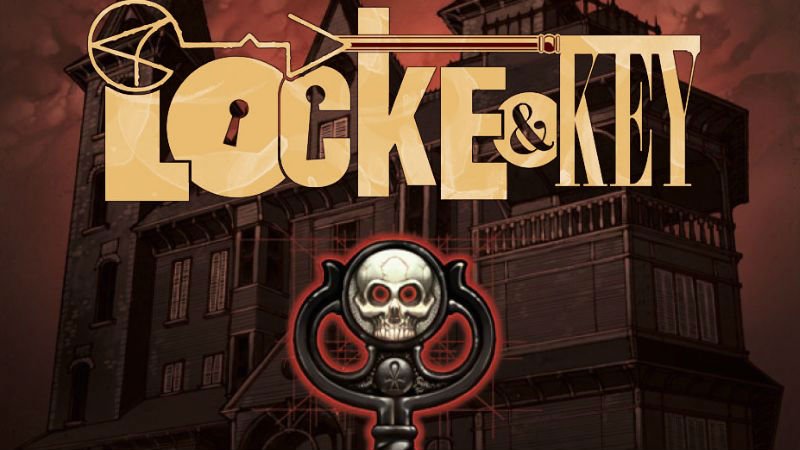Locke and Key Review: Artistically Impressive but Overall Mediocre

Skyler Johnson / Emertainment Monthly Staff Writer ’22
Locke and Key: Welcome to Lovecraft is the first volume of Joe Hill and Gabriel Rodriguez’s Locke and Key series. Published by IDW publishing, the first volume went from February to June of 2008 and had six issues.
The series was written by the American author Joe Hill, author of books such as Heart-Shaped Box, Horns, Nos4a2, and The Fireman. He writes mainly in the horror genre, Locke and Key being his first start in the comic book realm. Artist Gabriel Rodriguez just got his first major break doing art for a comics version of the CSI TV series, but is most known for this work. Both the artist and the writer, therefore, didn’t have a ton of experience doing comic books when they started with this series.

Locke and Key follows a family after the father of the family is brutally murdered in front of the wife and kids. They have moved from their home in California to a house in Lovecraft, Massachusetts into the father’s childhood home. The family has to deal with their own personal traumas related to the father’s death, and a supernatural threat that will do anything to get what it desires
.
As far as the main storyline is concerned, this is neither great nor terrible. It’s the most okay series I’ve read in a very long time. The series very much focuses on dealing with trauma, as all the characters have to deal with their own traumas in their own different ways. One character tries to deny he’s feeling anything, one character tries to push away other people, one character turns to drinking. This isn’t exactly a new trend. There have been countless stories where characters have to deal with trauma, and this doesn’t exactly add anything new to the mix.

But, this isn’t the only storyline. There’s also a large amount of time spent on the antagonist, Sam Lesser. Unfortunately, his storyline isn’t any more unique. He’s a fairly basic main antagonist who’s no more or less interesting then anyone else in this series. He’s a person who’s done really bad things but has a tragic backstory to make him more relatable. This backstory was, unfortunately, basic, as was a lot of his characterization. Just like with the main storyline, it’s been done before, and here it wasn’t done any better or worse.
As far as the art’s concerned, there are plenty of positives and plenty more negatives. Starting with the positives, overall, it fits the piece. It very much isn’t pretty to look at, but it does match the overall tone and themes. It’s ugly, but it’s ugly intentionally, and all of the horrifying parts of the series pop out as a result of the ugliness. And, for the most part, it works to the series’ benefit, highlighting some of the creepier moments. The series, overall, is pretty scary, and that’s largely due to the fact that the art style is so impactful.

However, a major problem in the art style is that a lot of the characters look really ugly, from the antagonists to the protagonists. While this doesn’t disallow the reader to still enjoy certain characters, there are a few problems with the protagonists’ homliness. The main one being that a lot of the characters look incredibly creepy, even the ones that aren’t supposed to, like all of the protagonists. Thus, they are more unlikeable as a result.
Furthermore, there are some scenes that were clever. For example, there’s one scene where a simple knock knock joke has more serious implications once the answer is revealed. This is a proper subversion of expectations that was done quite masterfully; something traditionally innocent becomes something sinister. This technique, if used effectively, creates a very chilling effect, and this series is a great example of an effective use.

Unfortunately, that’s about all the positives the series has. There are some major plot points that are completely brushed under the carpet. The biggest example is that two major characters both have very abrupt developments. One moment they’re a certain way, the next, they’re a completely different way. Consistently, you feel like you’re missing something, yet, in reality, you’re not. The characters seemingly abruptly shift, and the answers as to why they shift are as minor, both times, as conversations from teachers. From those conversations, they become completely different people. A mild mannered, kind kid becomes a violent criminal in a matter of panels. The result is that the characters’ arcs are anticlimactic and end unsatisfyingly.
Also, some of the scenes’ transitions don’t work well given the comic book genre and require a second glance to fully understand. While this is a minor note, it’s still important to mention that there are some pages where you’re going to have to read it a few times to understand it, and, ultimately, comics shouldn’t force the reader to do so.

Overall, while this is definitely not the worst thing I’ve read, it’s not the best either. If you’re a big fan of stories that deal with trauma, this story does a pretty good job of it, and you’ll enjoy it. If not, or if you think that the theme is too overdone, this series may not be the first one you should pick up.